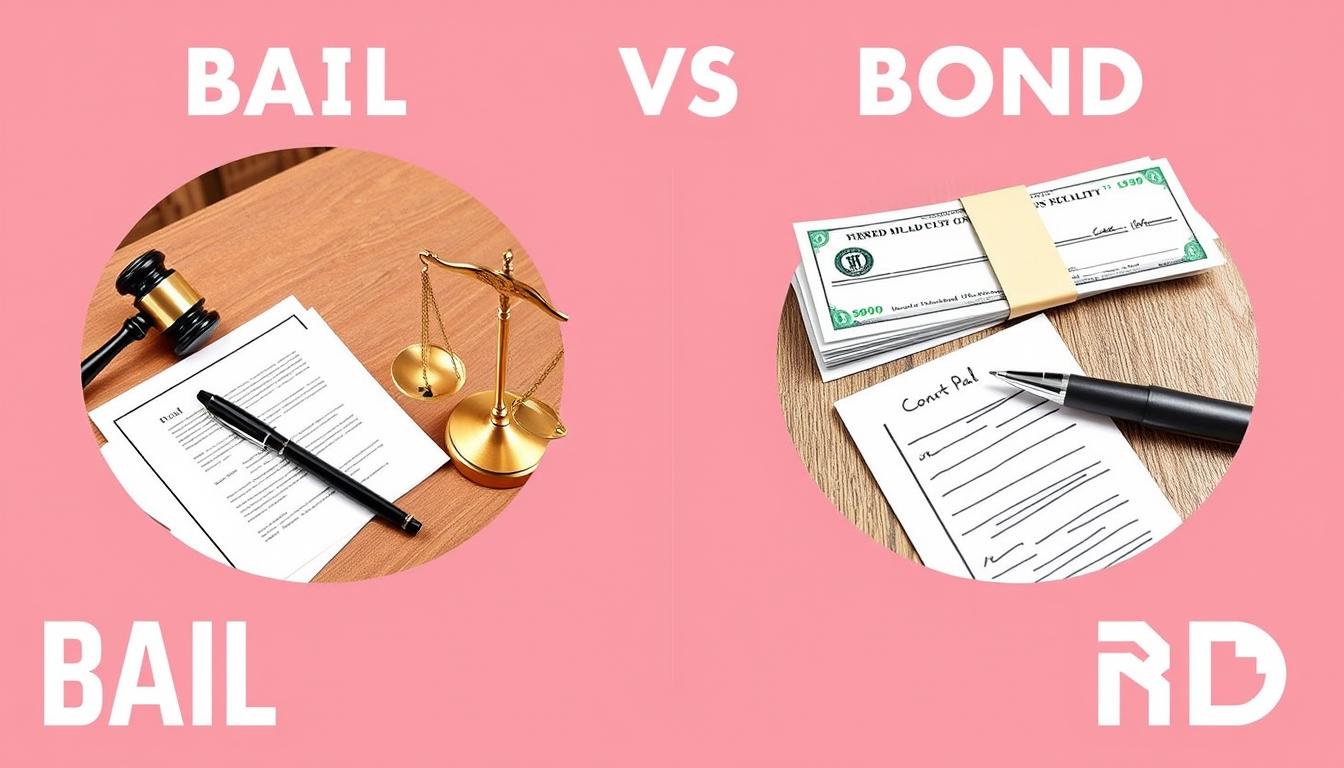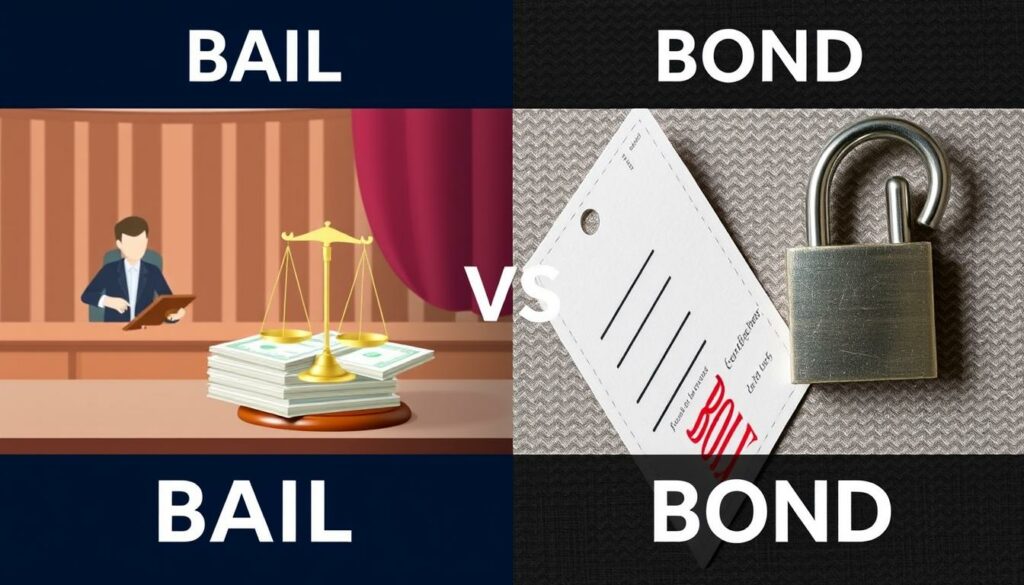
27 Jan What Is The Difference Between Bail and Bond?
In the world of criminal justice, knowing the difference between bail and is key. These terms are often mixed up, but they mean different things. Bail is money given to the court for release. A bond, on the other hand, involves a third party.
The difference between bail and bond is important for those facing charges. Bail lets defendants pay the court directly. A bond, through a bail bondsman, offers an alternative. This choice can change how much money is involved and what conditions come with release.
Understanding the difference between bail and bond is vital for those in the legal system. It affects how people get released, their financial commitments, and their court appearances. We will look into how these concepts shape the pre-trial process and impact defendants’ rights and duties.
Key Takeaways
- Bail is paid directly to the court; bond involves a third party
- Bail requires full payment; bond typically costs a percentage
- Both aim to ensure court appearance and compliance
- Financial implications differ between bail and bond options
- Understanding these differences is key for making informed choices
Understanding Bail vs Bond: Basic Definitions
It’s important to know the difference between bail and bond. A bail bond explanation helps those dealing with the legal system. Let’s look at the main ideas and important terms.
What Constitutes Bail in Legal Terms
Bail is money paid to the court. It makes sure a defendant shows up for court dates. The court decides how much bail to set. If bail is too high, you might get a bail bond from a licensed agent.
Definition of Bond in Legal Context
A bond is when someone else pays the bail if you don’t show up. This bail bond definition shows its role as a financial safety for the court. Bondsmen charge a fee for their help.
Key Terminology in the Bail Bond System
Knowing the bail bond system means understanding certain terms:
- Surety: The bondsman who guarantees payment
- Premium: The non-refundable fee charged for a bond
- Collateral: Assets used to secure a bond
- Forfeiture: Loss of bail money due to missed court dates
| Aspect | Bail | Bond |
|---|---|---|
| Payment To | Court directly | Bondsman |
| Refundable | Yes, if conditions met | No (premium fee) |
| Typical Cost | Full bail amount | 8-10% of bail amount |
Even though bail and bond share some similarities, like ensuring court appearances, knowing their differences is vital. This is true for defendants and their families.
The Legal Foundation of Bail and Bond Systems
The bail bond process in the United States is based on constitutional law. The Eighth Amendment of the U.S. Constitution says bail can’t be too high. This rule helps make sure defendants aren’t charged too much to get out of jail before trial.
It’s important to know the difference between bail and bond. Bail is the amount the court sets for release. A bond is a promise to pay that amount. These terms are often mixed up but are key in the justice system.

State laws also shape the bail bond process. They set rules for bail, who can post bond, and what conditions come with release. Some states have changed their laws to make things fairer, trying to avoid keeping people in jail because they’re poor.
| Legal Aspect | Bail | Bond |
|---|---|---|
| Constitutional Basis | 8th Amendment | State Laws |
| Primary Purpose | Ensure Court Appearance | Guarantee Bail Payment |
| Who Sets It | Court | Bail Bond Agent |
The bail and bond systems aim to keep everyone safe while assuming innocence. They let people out before trial but make sure they show up for court. Knowing how bail bonds work is key for those dealing with the criminal justice system. It affects defendants and their families a lot.
The Bail Process Explained
The bail vs bond process begins when someone is arrested. It’s important to know the difference between bail and bond. We’ll look at how bail amounts are decided and the types of bail available.
Setting Bail Amounts
Courts look at several things when setting bail. They consider the crime’s severity, the defendant’s past crimes, and their community ties. The cost of bail can change a lot based on these factors.
Factors Courts Consider
Judges think about many things when setting bail:
- Nature and circumstances of the offense
- Weight of evidence against the defendant
- Flight risk
- Community safety
- Financial resources of the defendant
Types of Bail Available
There are different types of bail for release:
| Bail Type | Description | Typical Use |
|---|---|---|
| Cash Bail | Full amount paid in cash | Lower bail amounts |
| Surety Bond | Bail bond agent guarantees payment | Higher bail amounts |
| Property Bond | Property used as collateral | Substantial bail amounts |
| Personal Recognizance | Released without payment | Low-risk defendants |
The bail vs bond process aims to ensure court appearance and protect community safety. Knowing these options helps defendants make better choices about their release.
How Bond Services Function
It’s important to know the difference between bail and bond when dealing with the law. Bond services help people get out of jail. They explain how these services work and what you should know about bail bond agents.
Role of Bail Bond Agents
Bail bond agents help connect defendants with the court. They offer financial guarantees for a defendant’s court appearance. They must follow certain rules, like having a license and insurance.

Bonding Company Operations
Bonding companies work with courts and police. They decide if they can post a bond for a case. If they agree, they promise to pay the full bail if the defendant doesn’t show up in court.
Cost Structure and Fees
Using a bail bond service costs between 10% to 15% of the bail amount. This fee is not refundable. It’s what the bail bond agent charges for their work. For instance, if bail is $10,000, the fee could be $1,000 to $1,500.
| Bail Amount | Bond Fee (10%) | Bond Fee (15%) |
|---|---|---|
| $5,000 | $500 | $750 |
| $10,000 | $1,000 | $1,500 |
| $25,000 | $2,500 | $3,750 |
Understanding bond services helps defendants make better choices. It’s key to think about the money involved and the responsibilities that come with using a bail bond agent.
Bail vs Bond: Core Differences and Similarities
It’s important to know the difference between bail and bond in the legal system. The main difference is who pays the court. Bail means the defendant pays the full amount directly. Bond, on the other hand, has a bail bondsman who pays for the defendant.

Bail and bond laws vary by state. But some key differences stay the same. Bail often requires a bigger upfront payment but can be returned if the defendant follows court orders. Bonds, though, require a smaller fee but are not refundable.
The differences between bail and bond also show in risk and convenience. Bail is all on the defendant, while bonds share the risk with the bondsman. Bonds are easier for those who can’t pay full bail.
| Aspect | Bail | Bond |
|---|---|---|
| Payment | Full amount to court | Fee to bondsman |
| Refund | Possible | Non-refundable |
| Risk | Defendant bears all | Shared with bondsman |
In court, judges look at flight risk and crime severity when setting bail or bond amounts. Both aim to make sure the defendant shows up for future court dates. But, the way they handle money is very different.
Financial Implications of Choosing Bail or Bond
When you’re in legal trouble, knowing the financial side of bail vs bond is key. We’ll look at the costs and how you can pay for both.
Cost Comparison Analysis
Bail bond fees are usually 10% to 15% of the bail amount. For instance, a $10,000 bail might cost $1,000 to $1,500 for a bond. On the other hand, paying bail directly means you pay the full amount upfront. This money is returned to you if your case is closed.
| Option | Upfront Cost | Refundable |
|---|---|---|
| Bail | Full amount | Yes |
| Bond | 10-15% of bail | No |
Payment Options and Terms
Bail bond services might let you pay in installments. They might take credit cards or ask for collateral. When you pay bail directly, you can use cash or property. Make sure you know the terms before you decide.
Refund Possibilities
Bail is usually refundable if you meet all court conditions. But bond fees are not refundable. This can affect your finances a lot. So, think carefully about bail or bond before making a choice.
Requirements and Conditions for Release
When defendants get pretrial release through bail vs bond, they must meet certain rules. The bail bond process is more than just paying a fee. Courts set rules to keep everyone safe and make sure the defendant shows up for trial.
- Travel restrictions
- Regular check-ins with law enforcement
- Substance abuse counseling
- Electronic monitoring
These rules change based on the crime and the defendant’s past. Breaking them can mean going back to jail. The rules for bail vs bond explain what’s expected of those released.
| Bail Requirements | Bond Requirements |
|---|---|
| Full payment to court | Premium payment to bondsman |
| Court-imposed conditions | Bondsman and court conditions |
| Potential property collateral | Cosigner often required |
It’s key for defendants and their families to understand these rules. This helps them follow the rules and avoid legal trouble before trial. The bail bond process might seem complex, but knowing what’s expected makes it easier to get through.
The Role of Court Appearances and Compliance
The bail vs bond court process has strict rules. It’s important for defendants to understand these rules. Court appearances and following the rules are key parts of bail vs bond requirements.
Appearance Obligations
Defendants must go to all court dates when released on bail or bond. The bail bond process clearly states when and where to show up. Missing court can cause big problems, no matter the release type.
Consequences of Non-compliance
Not following bail vs bond rules can lead to harsh penalties. Courts might take back the bail or bond, issue arrest warrants, or add more charges. Bail bond companies could also try to get their money back.
| Non-compliance Action | Consequence |
|---|---|
| Missed court date | Bail/bond forfeiture, arrest warrant |
| Violating release conditions | Revocation of bail/bond, immediate arrest |
| Leaving jurisdiction | New criminal charges, bail/bond revocation |
Courts and bail bond agents keep a close eye on compliance. They use different ways to make sure defendants follow the rules. This includes check-ins, electronic monitoring, or supervision by a third party.
Legal Rights and Responsibilities
Knowing bail vs bond legal terms is key when dealing with the justice system. This part talks about the rights and duties of everyone in the bail and bond process.
Defendant’s Rights
Defendants have certain rights under bail vs bond laws. They have the right to fair bail and to know the charges against them. Courts look at flight risk and public safety when setting bail.
Bondsman’s Obligations
A bail bond agent has big responsibilities to the court and their clients. They must:
- Make sure defendants show up in court
- Follow state laws
- Keep accurate records
- Keep client information private
Court’s Authority
Courts have a lot of power in the bail process. They can change or cancel bail for many reasons. If a defendant breaks bail rules, the court can issue a warrant.
| Party | Key Responsibilities |
|---|---|
| Defendant | Go to court, follow bail rules |
| Bail Bond Agent | Make sure defendants appear, follow laws |
| Court | Set fair bail, enforce rules |
Understanding these rights and duties helps people deal with the complex bail and bond world.
Common Misconceptions About Bail and Bond
Many people get confused about bail and bond. They think bail and bond are the same thing. But, bail is the amount set by the court, and a bond is a promise from a third party.
Some folks think posting bail means they get all their money back. But, that’s not always true. Courts might keep some of the money for fees or fines.
It’s important to know the difference between bail and bond. Bail is money given directly to the court. A bond, on the other hand, is a promise from a bail bondsman for a fee, usually 10% of the bail.
Even though bail and bond both help you get out of jail, they work differently. Bail is paid in full by the defendant or their family. A bond only needs a small payment to the bondsman.
- Bail is not always returned in full
- Bonds involve a non-refundable fee
- Bail and bond are not interchangeable terms
By understanding these points, defendants can make better choices. This helps them avoid expensive mistakes in the legal system.
Conclusion
The bail vs bond comparison shows key differences in the legal system. Bail is a direct payment to the court. On the other hand, a bond is a third-party guarantee. Knowing this difference is important for those facing legal issues.
We’ve looked at the financial and legal sides of bail and bond in this article. Choosing between them can greatly affect a defendant’s situation. Bail usually needs a bigger upfront payment but can be returned. Bonds require a smaller fee but are not refundable.
Understanding bail and bond can be tricky. Each option has its own duties and outcomes. It’s important to think about personal situations when making a choice. For advice specific to your case, talking to a qualified lawyer is a good idea.
Knowing about bail and bond helps people make better choices if they face this dilemma. This knowledge lets them deal with the legal system better. It also helps protect their rights during the process.

